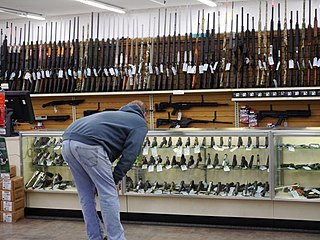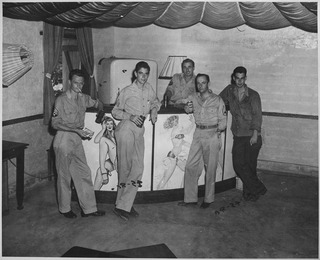Related Research Articles

Gun control is the set of laws or policies that regulate the manufacture, sale, transfer, possession, modification, or use of firearms by civilians.

The tobacco industry comprises those persons and companies who are engaged in the growth, preparation for sale, shipment, advertisement, and distribution of tobacco and tobacco-related products. It is a global industry; tobacco can grow in any warm, moist environment, which means it can be farmed on all continents except Antarctica.

More Guns, Less Crime is a book by John R. Lott Jr. that says violent crime rates go down when states pass "shall issue" concealed carry laws. He presents the results of his statistical analysis of crime data for every county in the United States during 29 years from 1977 to 2005. Each edition of the book was refereed by the University of Chicago Press. The book examines city, county and state level data from the entire United States and measures the impact of 13 different types of gun control laws on crime rates. The book expands on an earlier study published in 1997 by Lott and his co-author David Mustard in The Journal of Legal Studies and by Lott and his co-author John Whitley in The Journal of Law and Economics, October 2001.

The right to keep and bear arms is a right for people to possess weapons (arms) for the preservation of life, liberty, and property.
Arthur L. Kellermann is an American physician, epidemiologist, professor of emergency medicine at VCU School of Medicine, and CEO of the VCU Health System. He was formerly professor and dean of the F. Edward Hébert School of Medicine at the Uniformed Services University of the Health Sciences. Kellerman served as director of the RAND Institute of Health and founded the department of emergency medicine at Emory University and the Center for Injury Control at Rollins School of Public Health. His writings include 200 publications on various aspects of emergency cardiac care, health services research, injury prevention and the role of emergency departments in providing health care to the poor. Kellermann is known for his research on the epidemiology of firearm-related injuries and deaths, which he interpreted not as random, unavoidable acts but as preventable public-health priorities. Kellermann and his research have been strongly disputed by gun rights organizations, in particular by the National Rifle Association, although Kellermann's findings have been supported by a large body of peer-reviewed research finding that increasing gun ownership is associated with increased rates of homicide and violence.

A suicide method is any means by which a person chooses to end their life. Suicide attempts do not always result in death, and a nonfatal suicide attempt can leave the person with serious physical injuries, long-term health problems, and brain damage.
A waiting period is the period of time between when an action is requested or mandated and when it occurs.

Gun violence in the United States results in tens of thousands of deaths and injuries annually. In 2018, the most recent year for which data are available as of 2021, the Centers for Disease Control and Prevention's (CDC's) National Center for Health Statistics reports 38,390 deaths by firearm, of which 24,432 were by suicide. The rate of firearm deaths per 100,000 people rose from 10.3 per 100,000 in 1999 to 12 per 100,000 in 2017, with 109 people dying per day or about 14,542 homicides in total, being 11.9 per 100,000 in 2018. In 2010, there were 19,392 firearm-related suicides, and 11,078 firearm-related homicides in the U.S. In 2010, 358 murders were reported involving a rifle while 6,009 were reported involving a handgun; another 1,939 were reported with an unspecified type of firearm. In 2011, a total of 478,400 fatal and nonfatal violent crimes were committed with a firearm.

Gun-related violence is violence committed with the use of a firearm. Gun-related violence may or may not be considered criminal. Criminal violence includes homicide, assault with a deadly weapon, and suicide, or attempted suicide, depending on jurisdiction. Non-criminal violence includes accidental or unintentional injury and death. Also generally included in gun violence statistics are military or para-military activities.

Gun ownership is the status of owning a gun, either legal or illegal. In 2018, Small Arms Survey reported that there are over one billion small arms distributed globally, of which 857 million are in civilian hands. The Small Arms Survey stated that U.S. civilians alone account for 393 million of the worldwide total of civilian held firearms. This amounts to "120.5 firearms for every 100 residents."

Smoking in the United States military has been observed in previous wars, but smoking's close association with the United States military started in World War I when tobacco companies began to target military personnel through the distribution of cigarettes to servicemen and the eventual inclusion of cigarettes into rations. Although the military has attempted to implement tobacco control initiatives, the association between smoking and military personnel has persisted to the present day as smoking rates remain high, despite declines in civilian rates. Such high rates have led to questions about the effect of smoking from the apparent health risks to troop readiness and training costs.
The State of Texas is considered to have some of the most relaxed gun laws in the United States. Public concerns over gun control in Texas have increased in recent years as Mexican drug cartels continue to commit violent crimes closer to Texas' stretch of the Mexico–United States border. They have also increased due to the number of incidents, including misuse of firearms stolen from other sources.

Defensive gun use (DGU) is the use or presentation of a firearm for self-defense, defense of others or, in some cases, protecting property. The frequency of incidents involving DGU, and their effectiveness in providing safety and reducing crime is a controversial issue in gun politics and criminology, chiefly in the United States. Different authors and studies employ different criteria for what constitutes a defensive gun use which leads to controversy in comparing statistical results. Perceptions of defensive gun use are recurring themes in discussions over gun rights, gun control, armed police, open and concealed carry of firearms.

Proposals for universal background checks would require almost all firearms transactions in the United States to be recorded and go through the National Instant Criminal Background Check System (NICS), closing what is sometimes called the private sale exemption. Universal background checks are not required by U.S. federal law, but at least 22 states and the District of Columbia currently require background checks for at least some private sales of firearms.
The National Firearms Agreement (NFA), also sometimes called the National Agreement on Firearms, the National Firearms Agreement and Buyback Program, or the Nationwide Agreement on Firearms, was an agreement concerning firearm control made by Australasian Police Ministers' Council (APMC) in 1996, in response to the Port Arthur massacre that killed 35 people. Four days after the killings, the Australian Prime Minister John Howard told the parliament “We need to achieve a total prohibition on the ownership, possession, sale and importation of all automatic and semi-automatic weapons. That will be the essence of the proposal that will be put by the Commonwealth government at the meeting on Friday...". The laws to give effect to the Agreement were passed by Australian State governments only 12 days after the Port Arthur massacre.
Daniel W. Webster is an American health policy researcher and the director of the Center for Gun Policy and Research at Johns Hopkins University. He is also the deputy director for research at the Johns Hopkins Center for the Prevention of Youth Violence, and the first Bloomberg Professor of American Health at the Johns Hopkins Bloomberg School of Public Health. In 2016, he became the director of the Johns Hopkins-Baltimore Collaborative for Violence Reduction, a joint crime-fighting effort between Johns Hopkins and the Baltimore Police Department.
A child access prevention law makes it illegal for an adult to keep a gun in a place and manner so that a child can easily access and fire it. Proponents of these laws, such as the Law Center to Prevent Gun Violence, argue that they are effective at reducing accidental gun deaths among children, since they reduce accessibility and thereby risk. The National Rifle Association has lobbied against such laws, arguing that they are ineffective and infringe on the rights of gun owners to protect their homes.
Michael David Anestis is an American clinical psychologist and associate professor in the Department of Urban-Global Public Health in the Rutgers School of Public Health, as well as the executive director of the New Jersey Gun Violence Research Center. Before joining the faculty of Rutgers in 2020, he taught at the University of Southern Mississippi, where he first joined the faculty in 2012.
Douglas James Wiebe is associate professor of epidemiology at the Center for Clinical Epidemiology and Biostatistics in the Perelman School of Medicine at the University of Pennsylvania.
Charles C. Branas is the chair of the department of epidemiology at Columbia University's Mailman School of Public Health, a position he assumed on January 1, 2017. Before joining the Mailman School, he taught and conducted extensive research at the University of Pennsylvania's Perelman School of Medicine.
References
- 1 2 3 "Michael B. Siegel, MD". Boston University. Retrieved 1 August 2015.
- 1 2 Tavernise, Sabrina (22 February 2014). "A Hot Debate Over E-Cigarettes as a Path to Tobacco, or From It". New York Times. Retrieved 1 August 2015.
- 1 2 Beam, Alex (13 November 2007). "Where there's smoke...there's Dr. Siegel". The Boston Globe. Retrieved 1 August 2015.
- ↑ Siegel, Michael; Ross, Craig S.; King, Charles (November 2013). "The Relationship Between Gun Ownership and Firearm Homicide Rates in the United States, 1981–2010". American Journal of Public Health. 103 (11): 2098–2105. CiteSeerX 10.1.1.457.8466 . doi:10.2105/AJPH.2013.301409. PMC 3828709 . PMID 24028252.
- Michael Pizzi (2013-09-12). "Study: Gun ownership linked to increase in firearm homicides". Al Jazeera America.
- ↑ Siegel, M.; Ross, C. S.; King, C. (16 April 2014). "Examining the relationship between the prevalence of guns and homicide rates in the USA using a new and improved state-level gun ownership proxy". Injury Prevention. 20 (6): 424–426. doi:10.1136/injuryprev-2014-041187. PMID 24740937. S2CID 206980488.
- ↑ DeFilippis, Evan (25 January 2015). "The Myth of the Good Guy With a Gun". Slate. Retrieved 22 November 2015.
- ↑ Siegel, Michael B.; Rothman, Emily F. (20 January 2016). "Firearm Ownership and the Murder of Women in the United States: Evidence That the State-Level Firearm Ownership Rate Is Associated with the Nonstranger Femicide Rate". Violence and Gender. 3: 20–26. doi:10.1089/vio.2015.0047.
- ↑ "Study finds link between state gun ownership rates and murders of women". Phys.org. 26 January 2016. Retrieved 27 January 2016.
- ↑ Siegel, M; Rothman, EF (July 2016). "Firearm Ownership and Suicide Rates Among US Men and Women, 1981-2013". American Journal of Public Health. 106 (7): 1316–22. doi:10.2105/AJPH.2016.303182. PMC 4984734 . PMID 27196643.
- Amy Norton (2016-05-19). "States with more gun owners have more gun-related suicides". United Press International.
- ↑ Aaron, DG; Siegel, MB (3 October 2016). "Sponsorship of National Health Organizations by Two Major Soda Companies". American Journal of Preventive Medicine. 52 (1): 20–30. doi:10.1016/j.amepre.2016.08.010. PMID 27745783.
- Anahad O’Connor (2016-10-10). "Coke and Pepsi Give Millions to Public Health, Then Lobby Against It" . The New York Times.